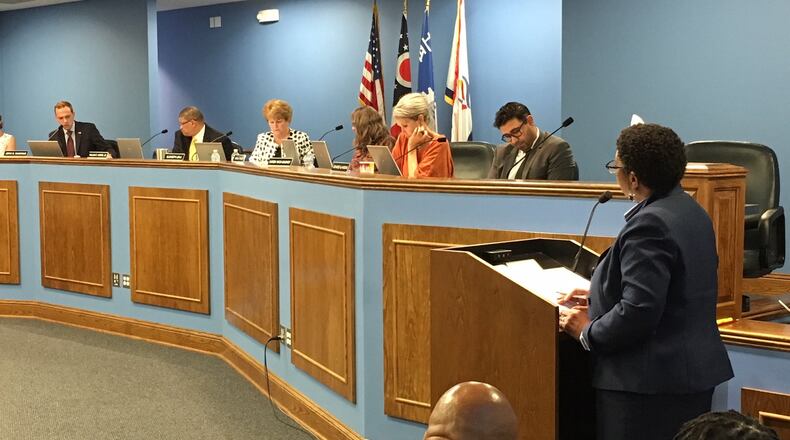MARCH: Variety of state leaders criticize school takeover law
Senate Education Committee Chair Peggy Lehner said she hopes to have a “readable draft” of a new school takeover bill ready Monday, to be reviewed in committee hearings this week. Whatever language the panel agrees on likely will be folded into the state budget bill, Lehner said. That means a conference committee would eventually have to resolve differences between House and Senate approaches.
Lehner said the core of the Senate language likely will be close to an Ohio School Transformation Plan that her workgroup produced last month.
“We definitely have a couple of aims, one of which is a lot more local control than the (current system) provides, but at the same time, a lot more expert help and consultation for the locals,” said Lehner, R-Kettering.
A May 7 draft of the workgroup’s plan prescribes a new path for school districts that receive three straight overall F’s on the state report card. Currently, those districts go straight into an Academic Distress Commission, where a CEO and outside-appointed board have broad powers to change district operations.
RELATED: Dayton schools misunderstood takeover timeline
The workgroup’s plan calls for those districts to spend at least two years working together with an outside consultant and a “transformation board” to discover “root causes” of underperformance and get the district moving in the right direction. Only if that fails would an ADC take over.
“If you’re sick, you go to a doctor. If you have legal problems, you go to a lawyer,” Lehner said. “Well, if you’re having school failure problems, maybe it’s time to bring in some consultants on school failure.”
In a marathon May 29 Senate Education Committee hearing, some pushed back against the idea. Some called it just another version of takeover, by a transformation board instead of a commission. Others said that low state report card grades, based largely on standardized test scores, were not an accurate indication that schools were failing.
“It is important to note that state takeovers are based on misleading state report cards that severely penalize students and districts in poverty,” said Becky Higgins, president of the Ohio Education Association teachers union.
FEBRUARY: Legislator cites major momentum to change law
Students in high-poverty communities are, on average, behind their peers academically by the time the school first interacts with them in kindergarten. Many have called for a system of social supports in those districts, to remove non-academic barriers to learning.
Lehner acknowledged that the state needs more ways of measuring progress.
“If our benchmarks are going to be strictly the results of tests, we might as well hang it up and go home right now,” she said. “We really have to develop a series of smaller benchmarks that can indicate whether we are moving in the right direction. We’ve focused far too much on that overall letter grade.”
Dayton Public Schools Superintendent Elizabeth Lolli also testified at that Senate hearing, calling the current takeover system a distraction that has divided communities in Youngstown, Lorain and East Cleveland.
She said Dayton’s ongoing efforts at turnaround — retraining staff, working on attendance, opening a health clinic — should be given a chance. She said Dayton’s early raw scores from 2019 state testing are higher, but it’s too early to know the report card impact.
RELATED: Dayton schools approve strategic spending plan
“As much as we might like a simple and quick answer for improving high-poverty schools whose students have experienced profound lack of opportunity and inequity, there is none,” Lolli said. “The magic that creates successful schools is strong leadership, quality teaching and high expectations for students. Creating a supportive and aspirational culture is what counts. Doing that takes time and an army of highly committed administrators and teachers — not the imposition of outsiders who haven’t been on the ground or in our school buildings.”
That’s a frequent battle in the school takeover discussion — is it more important to have deep, longstanding knowledge of the issues in a community, or to have a jolt of outside energy and expertise in a place that has struggled for years? Lehner suggested a mix.
“We’re hoping to develop much more of a partnership, rather than someone standing over you with a club,” she said.
Lehner said getting community buy-in for turning around schools is difficult but crucial, saying she sees signs of that in Dayton. She said any new system should focus more at the individual school level than Ohio has done in the past, not assuming that a one-size-fits-all fix will work.
EDUCATION: Summer food programs key for kids in tornado-hit areas
“It’s just really hard to turn them around,” Lehner said. “We do need time for things to work. No one is going to turn around a district — I don’t care what kind of superstar they might be — in a year, or two, or probably even three. We have to give programs time, which means we need to develop small, shorter-term benchmarks that tell us whether we’re seeing any progress.”
Lehner defended the fact that her workgroup and the people the group interviewed were dominated by politicians, superintendents and interest groups, at the expense of teachers or principals.
“Really, for turnaround efforts, the people we need to bring on board most are more administrators, superintendents, leaders, than the actual classroom teachers,” she said. “I do think the classroom teacher’s voice is important. Just because it wasn’t present in that workgroup, that’s people looking for reasons to throw stones.”
About the Author

